NRAO eNews
Volume 9, Issue 5
9 June 2016
NRAO eNews
Volume 9, Issue 5 • 9 June 2016

Upcoming Events

AAS Splinter Session: North American ALMA Development Program
Jun 14, 2016 | San Diego, CA

U.S. Radio/Millimeter/Submillimeter Science Futures II
Aug 3 - 5, 2016 | Baltimore, MD

NA ALMA Development Program Workshop
Aug 24, 2016 | Charlottesville, VA

Metrology and Control of Large Telescopes
Sep 19 - 24, 2016 | Green Bank, WV

Half a Decade of ALMA: Cosmic Dawns Transformed
Sep 20 - 23, 2016 | Indian Wells, CA

Coexisting with Radio Frequency Interference
Oct 17 - 20, 2016 | Socorro, NM
Registration Open for U.S. Radio Futures II
U.S. Radio – Millimeter – Submillimeter Science Futures II
3 – 5 August 2016
Baltimore, Maryland
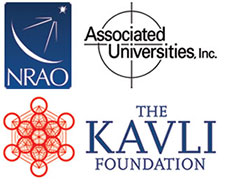
Funded by Associated Universities, Inc. (AUI) and the Kavli Foundation, the second in a series of three conferences for the astronomical community to broadly discuss potential U.S. futures for radio-millimeter-submillimeter science in the 2020’s and beyond will be held 3-5 August 2016 at the Renaissance Baltimore Harborplace Hotel in Baltimore.
Registration is now open at the Futures II conference website.
The 125 attendees at the first of U.S. Radio Futures conference, held in Chicago in December 2015, produced a compelling set of Science Working Group Reports that are key inputs to the exploration of the scope, feasibility, and transformational science expected from the leading future radio-millimeter-submillimeter instrument and technique options.
Parallel sessions at Futures II in Baltimore will broadly discuss potential radio-millimeter-submillimeter “Flagship” and “Small/Midscale” initiatives over the planned three days of the conference. Flagship options are major investments for instruments with widespread community benefit and support that will require funding by or on a scale comparable to the National Science Foundation (NSF) – Major Research Equipment and Facility Construction (MREFC) line. Small/Midscale initiatives are significant investments that might be funded via the NSF Mid-Scale Initiative Program (MSIP) line, such as experiments emerging from smaller groups and collaborations.
Please join us in Baltimore in early August for this important and continuing discussion of the future of U.S. radio-millimeter-submillimeter science!
Registration Open for Half a Decade of ALMA

We are pleased to announce that registration is now OPEN for the Half a Decade of ALMA: Cosmic Dawns Transformed conference which will be held 20 - 23 September 2016 at the Renaissance Indian Wells Resort in Indian Wells, California, USA (near Palm Springs).
The sensitivity and spectral grasp of the Atacama Large Millimeter/ submillimeter Array (ALMA) have revolutionized the study of the youngest structures in the Universe, from galaxy assembly through the formation of stars and planets. ALMA has produced over 400 refereed papers with over 4500 citations just beyond its four-year mark, reporting impressive and scientifically compelling results as the most sensitive and highest resolution mm/submm interferometer in the world.
This four-day international conference will highlight recent ALMA scientific results at the threshold of its fifth year of operation and bring together researchers from around the world to motivate collaborations for ALMA Cycle 5. Science topics will include all fields of astronomy: cosmology and galaxies in the distant Universe, nearby galaxies and the Galactic Center, the interstellar medium and star formation in our Galaxy, astrochemistry, circumstellar disks, exoplanets, solar system, stellar evolution and the Sun, and more.
Please submit an abstract featuring your science soon, as the deadline for abstracts to be considered for oral presentation will be 24 June.
Poster submissions will continue to be accepted through 1 August.
Early Registration will take place from 6 June - 1 August at a rate of $450. Between 1 - 22 August, the registration fee increases to $650. Registration will close on 22 August.
Students can register at any time before 23 August for a reduced rate of $250.
Book your room at the Indian Wells Resort at the time of registration to receive an instant $50 resort credit and become eligible for special room upgrades. Winners will be chosen at random and if you book before 1 July, you will double your chances to win.
Students are automatically eligible, with the submission of an abstract, to receive half the advertised room rate (a value of ~$400).
Please visit the conference website for updates, timeline of events - abstract submission deadline, registration closing - and future announcements, and contact the Local Organizing Committee at ALMA5yrs@nrao.edu with any questions including the opportunity for travel support (requests due on 1 July 2016).
Registration Open for Metrology & Control of Large Telescopes

This conference will cover a range of topics related to the metrology and control of large telescopes, including: development and evaluation of pointing models; measurement of mirror figure and alignment; flexible body control; modern servo control theory and implementation; and auxiliary metrology systems. The emphasis is on centimeter-wave astronomical telescopes, but many topics will also be relevant to deep space network antennas, and extremely large optical telescopes.
This workshop will be limited to ~50 external participants from outside NRAO Green Bank, with additional local attendees. Registration includes all workshop talks and materials. All housing and meals will be provided on the Green Bank site.
For more information, visit the conference website, or email rprestag@nrao.edu
New NRAO CDL Director: Brent Carlson

I am pleased to announce that Brent Carlson will be the next Director of the NRAO Central Development Laboratory (CDL).
Brent is currently a Senior Designer working for the National Research Council of Canada at the Dominion Radio Astrophysical Observatory in Penticton, British Columbia. Brent is widely-acknowledged as the global expert in digital engineering for radio astronomy, including correlator design and construction. From mid‐2002 to early 2010, he was the principal engineer and technical leader of the Wideband Interferometric Digital Architecture Correlator (WIDAR) project for the Expanded Very Large Array. He has extensive experience developing large real‐time signal processing systems for radio astronomy, and is the domain expert and chief system engineer for the Canadian‐led Square Kilometre Array (SKA) – Central Signal Processing consortium, as well as technical lead of the powerMX Field Programmable Gate Array platform, code-named “Talon,” that is being developed for the SKA1-Mid correlator/beamformer project.
As NRAO continues to develop innovative instrumental options for the future, such as the next-generation Very Large Array (ngVLA) and phased array feeds for the Atacama Large Millimeter/submillimeter Array (ALMA), Brent’s experience, creativity, and organizational skills will quickly move NRAO and the CDL into leadership roles for multiple key technologies.
Importantly, I would like to thank S.K. Pan and Bob Dickman for their outstanding efforts in leading the CDL over the past several years. Pan expertly guided the lab through very difficult budget times in 2012 and 2013. Bob continued that careful work and assumed a major leadership role in the definition of a new vision for the CDL and NRAO over the past two years. Pan and Bob put aside their personal interests and opportunities to strongly support CDL and the Observatory at a critical time, and we owe them a great deal.
Brent will arrive in Charlottesville and take up his position as CDL Director in August. Please join me in welcoming Brent to the National Radio Astronomy Observatory!
Telescope Time Allocation for Semester 2016B

The Observatory has completed the Semester 2016B time allocation process for the Very Large Array (VLA), the Very Long Baseline Array (VLBA) / High Sensitivity Array (HSA), and the Green Bank Telescope (GBT). A total of 326 new proposals were received for the 1 February 2016 submission deadline. A record number of proposals was received for the Global 3mm VLBI Array (GMVA) as a result, in part, of the participation of ALMA (Cycle 4) for the first time. In aggregate, the proposals covered a broad spectrum of modern research in astronomy and astrophysics.
The proposals were reviewed for scientific merit by eight Science Review Panels (SRPs) and for technical feasibility by NRAO staff. These reviews were completed in March 2016 and then considered by the Time Allocation Committee (TAC) at a face-to-face meeting on 18-19 April 2016 at NRAO in Green Bank, WV. The TAC consists of the SRP chairs and was charged with recommending a science program for Semester 2016B to the NRAO Director. The recommended program was reviewed and approved on 13 May 2016.
A disposition letter was sent to the Principal Investigator and Co-Investigators of each proposal on 18 May 2016. A TAC report containing information for proposers and observers, including statistics and telescope pressure plots, was released the same day. The approved science program has been posted to the NRAO science website. For each approved proposal in the science program, the Proposal Finder Tool will have access to its authors, title, abstract, and approved NRAO hours.
We would like to remind our users that the Student Observing Support program resumed for 2016, as announced in the July 2015 NRAO eNews. We encourage Principal Investigators on successful NRAO observing programs to consider applying for support.
The Observatory welcomes community feedback on its proposal review and time allocation process. Please provide such feedback via the Proposal Review department of the NRAO Helpdesk.
ALMA Program News
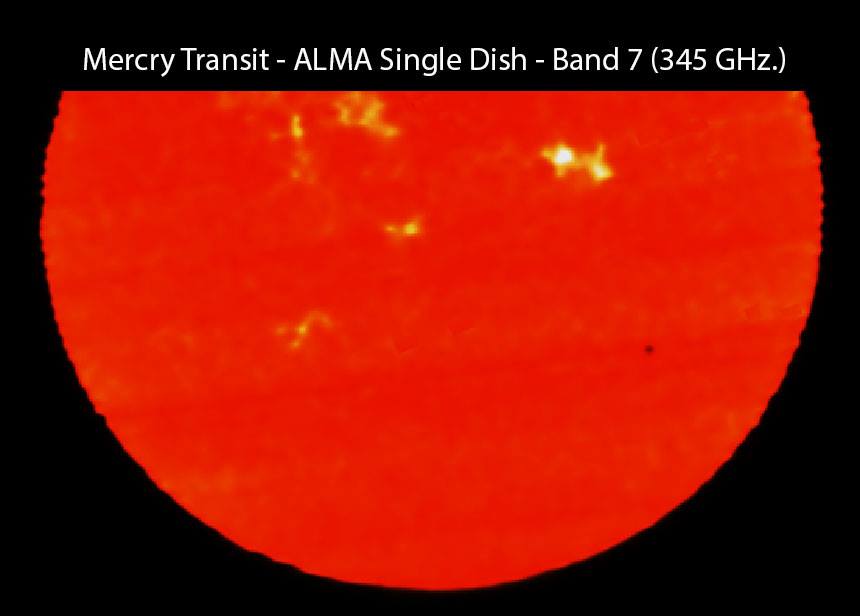
S. Asayama, ALMA (NAOJ/ESO/NRAO)
Mercury in transit across the Sun on 9 May 2016, captured by a single ALMA antenna tuned to 345 GHz. Compare for example to the NASA movie from the Solar Dynamics Observatory.
[click to enlarge]
Cycle 4 Proposal Deadline
The ALMA Cycle 4 proposal deadline was 21 April 2016. Initial science assessment is now under way by the 148 members of the eighteen Cycle 4 review panels. The panels meet in Vienna, Austria, 21-23 June to come to a preliminary ranking of the 1573 Cycle 4 proposals requesting just over 12,000 hours of 12m array time (over 6000 hrs of ACA time was requested). There was considerable interest in new observing modes. ALMA received more than two dozen large proposals, nearly two dozen Very Long Baseline Interferometry proposals, and more than four dozen solar proposals. Principal Investigator notifications are scheduled for delivery at the end of July.
Cycle 3 Science Observing
The ALMA 12m array has moved to configuration C40-4, which is equivalent to C36-(3)/4/(5) and provides 0.9” resolution at 100 GHz on the 15 – 704m ALMA baselines. During the middle of July, antennas will be moved to longer baselines in the C40-5 array, equivalent to C36-(4)/5/(6), providing 0.5" resolution at 100 GHz.
North American ALMA Development Program
The North American ALMA Development Study program received 12 submissions at its 2 May 2016 Call for Proposals deadline. Along with 12 Principal Investigators, there were 34 Co-Investigators from nine institutions. Funding requests totaled $2.2M. Proposals will be reviewed by an external review committee, whose members were nominated by the ALMA North America Science Advisory Committee and consented to by the National Science Foundation.
There will be an ALMA Development splinter session at the summer American Astronomical Society meeting in San Diego on 14 June. The current program status will be presented and discussed. A one-day Development Workshop will be held in Charlottesville, Virginia on 24 August 2016, for which registration will soon open.
The ALMA Band 1 cartridge, nominally covering 35-50 GHz, passed its Critical Design Review and been approved by the ALMA Board for installation on the array. The ALMA Band 1 science cases extend the array's spectral grasp at its lower frequency end, enabling key science drivers which include the evolution of grains in protoplanetary disks and debris disks, and characterization of molecular gas in galaxies during the era of re-ionization. NRAO provided mixers for these cartridges, which were built by the East Asian ALMA partners.
Conferences
Registration and abstract submission are open for the international ALMA science conference, Half a Decade of ALMA: Cosmic Dawns Transformed, which will be held in Indian Wells, California 20-23 September 2016. Abstract acceptance for contributed talks will remain open until 24 June. Please see the separate news item in this issue of eNews.
The VLA Sky Survey Pilot Begins
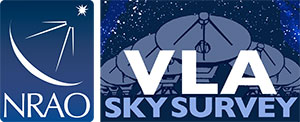
The Very Large Array Sky Survey (VLASS) will be a three-epoch (32-month cadence), all-sky, S-band (2-4 GHz) continuum polarimetry survey with 2.5-arcsecond spatial resolution. The survey will span seven years and six VLA configuration cycles, and will begin in 2017, pending successful achievement of the design phase milestones. The total VLA telescope time required for the survey is ~5400 hours, or ~900 hours per configuration cycle.
With the decision to proceed with the VLASS (see 17 Dec 2015 e-News), a 200-hr pilot in the recently commenced VLA B-configuration of semester 2016A has been approved, with the first observations starting June 2016. This pilot survey will inform VLASS implementation and operational issues associated with the full survey as input to design reviews, while at the same time providing the community with early VLASS-type data products. The pilot will be observed in as similar a mode to the full VLASS as possible, including:
- S-band (2-4 GHz), 1024 x 2 MHz channels
- VLA B-configuration, 2.5-arcsec resolution
- On-The-Fly (OTF) mosaics scanning at 3.31 arcmin/sec in right ascension, at constant declination
- Net mapping speed ~20 deg2/hr, 4-hr scheduling blocks covering 80 deg2 (10o x 8o tiles)
Some areas will be covered with three passes to provide a similar sensitivity as that expected from three epochs of the full VLASS (70 microJy/beam), while others will be observed with a single pass (120 microJy/beam) to maximize sky coverage. The pilot will cover key galactic and extragalactic fields that have good multi-wavelength ancillary data, as well as covering areas of sky with good prior radio observations for technical validation of the OTF mosaicking observing mode. The total area to be covered will be ~2500 deg2, and will include:
VLASS Pilot Fields, 3 passes (70 microJy/beam):
- Galactic Plane fields: Galactic Center, Cygnus, Cepheus
- Extragalactic fields: Cosmological Evolution Survey, Sloane Digital Sky Survey (SDSS) Stripe 82, Chandra Deep Field South
VLASS Pilot Fields, 1 pass (120 microJy/beam):
- SDSS South Galactic Cap / FIRST southern sky for declination > 0 deg
- SDSS North Galactic Cap fields: Great Observatories Origins Deep Survey – North, Elais-N1, Lockman Hole, H-ATLAS North, Bootes
Raw visibility data will be immediately available through the NRAO archive under project code TVPILOT. Data products (calibrated visibility data, images) will be made available after undergoing quality assurance.
At this time, we encourage community participation in various Science Working Groups as we define and refine the operational aspects of the pilot survey:
- Extragalactic Working Group
- Galactic Working Group
- Transients Working Group
- Polarization Working Group
- EPO Working Group
- Survey Implementation Working Group
- NRAO Data Products, Archiving and Enhanced Data Products Working Group
A Google Group has been set up to facilitate discussion and communication within the working groups, please visit to sign up.
MUSTANG-2 First Light at GBT
On 23 May, the recently completed MUSTANG-2 camera achieved first light on the NRAO Green Bank Telescope (GBT). MUSTANG-2 consists of an array of 211 feed horns outfitted with Transition-Edge Superconducting bolometers, read out by a microwave resonator multiplexer. The detectors are cooled to 300 mK to improve their sensitivity. With a larger, 4 arcminute diameter field-of-view and more numerous, more sensitive detectors than its precursor, MUSTANG-2 enables unprecedentedly detailed study of phenomena from dust in our own Galaxy to the Sunyaev-Zel’dovich Effect in the most distant galaxy clusters. After a brief evaluation period over the next few weeks, the receiver will return for GBT science observations in the fall.
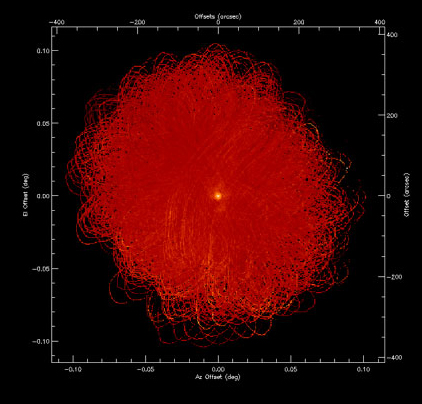
Sgr A* at ~20 deg. elevation (3 airmasses) through heavy clouds — 8 minutes of observation during MUSTANG-2 commissioning.
[click to enlarge]
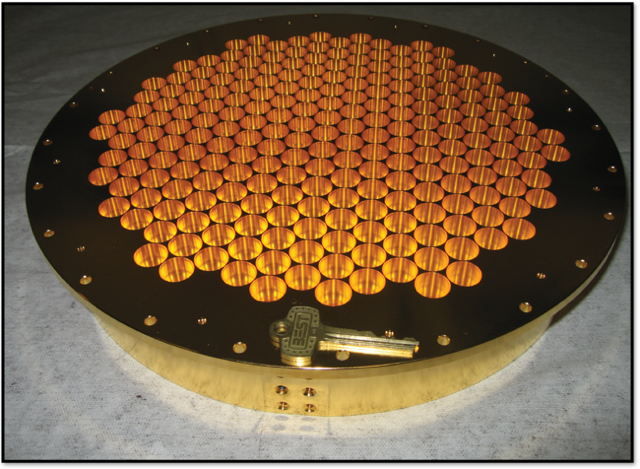
The MUSTANG-2 array of feed horns.
[click to enlarge]
VLBA Antenna Pair Demonstrates 4 Gbps Mode

32 base-band channels, each 32 MHz wide, correlated on the Pie Town to Mauna Kea baseline. [Top] Phase as a function of frequency, with the slope indicating a typical residual delay (~ 20 nanosec). [Bottom] Amplitudes vary due to the structure of 3C345 as a function of baseline length (measured in wavelengths) which span nearly a factor of two across the observing bands (4160 to 7840 MHz). Note channels are not in a natural order and two "non-channels" (17th and 25th) provide no useful data.
[click to enlarge]
Starting in 2008, new digital electronics and recorders were installed on the Very Long Baseline Array (VLBA) as part of ongoing efforts to improve the array’s sensitivity. The instrument's usable bandwidth was increased from 64 MHz of bandwidth per polarization to 256 MHz with the most restrictive limitation being throughput of the Mark5C recorders. A 4 Gbps capability was demonstrated in a test using the Pie Town and Mauna Kea antennas on 21 April 2016. Two ROACH Digital Back Ends using the Polyphase Filter-Bank personality, each fed a separate Mark5C recorder (see Figure).
A second four-station test was performed 23 May 2016. Results will be available in the next month. Tests were performed in a non-operational mode (hand-created files and hand-configured instrumentation). The cost and effort to make this operational across the VLBA is being evaluated with possible roll-out of this new capability over the next year or two.
While doubling the bandwidth would be a welcome improvement for almost all VLBA continuum science, it is especially attractive to 3mm Very Long Baseline Interferometry (VLBI) observations, where short atmospheric coherence times require high sensitivity, and where several other antennas comprising the Global Millimeter VLBI Array (GMVA) either already have or are developing similar capabilities. The GMVA is coordinated by the Max Planck Institute for Radio Astronomy and has been supporting the VLBA in testing and through contribution of recorder resources.
References
GMVA: http://www3.mpifr-bonn.mpg.de/div/vlbi/globalmm/
VLBA Sensitivity Upgrade Project: http://library.nrao.edu/vlbau.shtml
NRAO Launches its First Mobile App: RadioSky

[click to enlarge]
The NRAO is bringing a whole new view of the cosmos – as seen at radio wavelengths – right to your mobile device. Intriguing views of the invisible Universe, and much more, are part of NRAO's new, free iOS app, called RadioSky.
RadioSky shows how familiar celestial objects, along with objects invisible to even the most advanced optical telescopes, look when viewed with NRAO's world-class research radio telescopes. You can browse an all-sky map and choose objects to explore through NRAO's powerful radio eyes, learning fascinating details about each of these objects.
The app features an introduction to radio astronomy, information about NRAO and about each of our telescopes, along with streaming videos with behind-the-scenes virtual tours of our facilities and explanations by the astronomers who use them.
Also included are instructions on how to build your own "itty-bitty radio telescope" from an old satellite dish. Once you've built this educational tool, the app guides you through a series of hands-on experiments that illustrate the basics of radio observations. The experiments include observing the Sun, detecting the radio waves coming naturally from your own body, and finding geosynchronous satellites in the sky.
RadioSky is a valuable resource for educators, experimenters, and anyone interested in the Universe and how it works.
Download this free iOS app from the App Store:
https://itunes.apple.com/us/app/radiosky/id1115228545
Recent Media Releases
Career Opportunities
Research Engineer in Millimeter and Submillimeter Wavelength Electronics: The NRAO in Charlottesville, Virginia invites applications from research engineers with expertise in millimeter/sub-millimeter wavelength electronics. The successful candidate will be a member of the NRAO scientific staff and will join the millimeter/sub-millimeter receiver group in the Central Development Laboratory in Charlottesville. She/he will play a leading role in a program of design and development of low-noise millimeter/sub-millimeter wavelength instrumentation for astrophysical observation, a key technology area for the next generation of radio telescope instrumentation.
Division Head Electronics: The NRAO in Green Bank, West Virginia is actively seeking a Division Head for the Electronics Division. The successful candidate will become a member of the NRAO Green Bank operations team that oversees the development and operation of the Robert C. Byrd Green Bank Telescope (GBT), the world’s largest fully steerable telescope, as well as other smaller telescopes used for a variety of scientific and educational purposes. Working at wavelengths from 100 cm - 3 mm, the GBT supports a diverse program of scientific research. The Electronics Division currently consists of ten engineers and nine technicians divided into two groups – microwave and digital – both with group leads. The Electronics Division Head is responsible for managing the Division as well as working with the other Green Bank division heads to plan the future of the telescopes and optimize their scientific use.
For additional information on these openings and other NRAO career opportunities, please visit the NRAO – Career Opportunities web pages.
From the Archives
Ellen Bouton

[click to enlarge]
About this month's photograph: The NRAO Microwave Anisotropy Probe (MAP) team in 1996 [left to right] John Webber, Ed Wollack, Nancyjane Bailey, Bill Lakatosh, Skip Thacker, and Marian Pospieszalski. Twenty years ago, in June 1996, NASA contracted with NRAO to design and build amplifiers for the MAP, later renamed the Wilkinson Microwave Anisotropy Probe (WMAP) after Dr. David Wilkinson, a member of the science team and pioneer in the study of cosmic background radiation. The WMAP satellite mapped the temperature of the background sky in five spectral bands with an angular resolution of 0.3 degrees and sensitivity of 20 micro-Kelvins/pixel after a nine-year mission (Sep 2001 – Aug 2010). These measurements have helped to secure rigorous constraints on the origin, content, age, and geometry of the Universe (see http://map.gsfc.nasa.gov/).
The unique elements which made MAP possible were the cooled amplifiers developed by NRAO's Marian Pospieszalski using Hughes Research Laboratories high electron mobility transistors. The critical step in this process was the development in 1995 by the Central Development Laboratory (CDL) of an amplifier with center frequency of 80 GHz satisfying all mission requirements. The measured parameters of this amplifier were used in the final Medium Class Explorers (MIDEX) mission technical proposal submitted to NASA in December 1995. The MAP amplifiers represented a significant step in evolution of the design of low-noise amplifiers, and a step in refining and improving the assembly process, resulting in a remarkable level of consistency and repeatability of performance.
The MAP team produced 120 space-qualified amplifiers covering five frequency bands: 20 – 25, 28 – 37, 35 – 46, 53 – 69, and 82 – 104 GHz. The team worked full-tilt on production for several years, and the entire CDL celebrated on 23 October 1999 when the last of these 120 amplifiers were shipped. Other MAP team participants not included in the photo: Tod Boyd, Ron Harris, Greg Morris, Gerry Petencin, and Bill Wireman; machine shop support came from Tony Marshall, Garnett Taylor, and Matt Dillon, and plating support from Vince Summers. Many thanks to Marian Pospieszalski and Ed Wollack for caption information.
From the Archives is an ongoing series illustrating NRAO and U.S. radio astronomy history via images selected from our collections of individuals' and institutional papers. If readers have images they believe would be of interest to the Archives, please contact Ellen Bouton.

